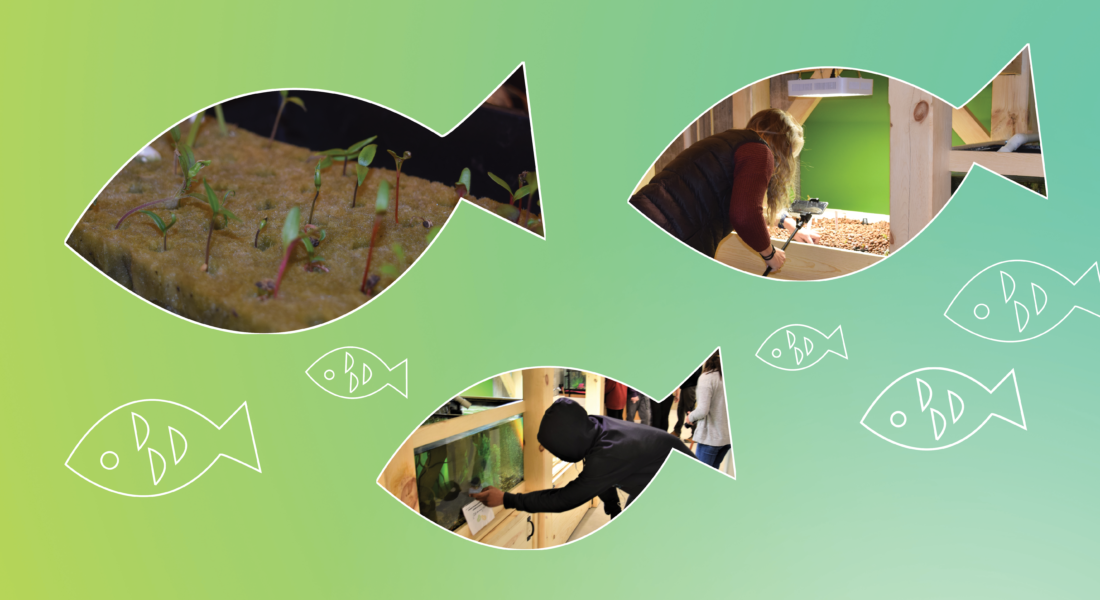Question: When can you harvest lettuce in Minnesota? How about beans?
Answer: Any time of year (when you have the right equipment, that is!).

May 2021 – This past year, Camp Fire Minnesota added an aquaponics system to the lower level of Tanadoona’s new Community & Dining Center. The brand-new system, complete with ten bluegill sunfish and rotating crops of veggies and herbs has already been a valuable teaching resource for year-round environmental education lessons.
We were thrilled to partner with the team at Spark-Y, who built the system, and trained our naturalists how to maintain it and use it in new hands-on, STEM-focused lessons with youth.
“Aquaponics is full-cycle—you plan something, grow it, and harvest it. Those are the catalysts for transformation that I think is the greatest outcome. By caring for the plants and the fish, you learn something about yourself and you see yourself in a new way. Those hands-on experiences are palpable—it doesn’t just take place in a textbook. You can use the aquaponics system as a vehicle for change,” says Zach Robinson, Executive Director at Spark-Y.

Not familiar with the ins and outs of aquaponics? We pulled a few cliff notes from a My Nature Connection lesson to get you up to speed.
Aquaponics is a method of growing vegetables and fish through an aquatic farming system. Plants and fish form a symbiotic relationship when the fish rely on the plants for survival, and the plants rely on the fish.
Aquaponics is a three-part cycle.
1. First, the fish are fed. The fish then produce waste that they release into the water. That water is carried from the fish tank through tubes, where the solid waste gets trapped in a filter and the nutrient-filled water flows toward the plants.
2. Bacteria transforms the waste in the water into nutrients for the plants. Plants cannot absorb the ammonia found in fish waste, but bacteria turn it into nitrates, which plants love!
3. Finally, plants filter the water before it is released back into the fish tank.
Aquaponics is a sustainable way to grow food—you need less soil and water, and it eliminates the need for pesticides. Plus, fresh food is available year-round without taking up much space, making it perfect for urban gardening!
Find the full lesson here to learn more about the aquaponics cycle and try a hands-on activity.

Throughout the winter, our naturalists used the aquaponics system in virtual lessons with schools. Due to COVID-19, they had to get creative, bringing the camera up close to show students the sprouting seedlings and the bluegills peering through the seaweed.
“Even virtually, it’s really cool to teach about aquaponics since there’s a lot of moving parts, but I’m excited for students to feed the fish, harvest the food, and experience all the steps in-person. The system encompasses so many different topics that could spark youths’ interest—like plant and fish life, water filtration, and engineering. It also has an element of accessibility—youth could potentially bring the concept of urban gardening into their own communities,” explains Camp Fire Naturalist Kelly Thurmes.
This spring, our first school group interacted with the system in-person. Menlo Park Academy students selected and planted the herbs we’ll be growing this season. They also tested the water quality, “oohing” and “aahing” in fascination over a rainbow reaction in one of their vials.
The possibilities for how we can use our new aquaponics system is endless. We look forward to incorporating it into lessons year-round and helping more youth get creative with sustainability!
A special thank you to the Opus Foundation for making the installation of our aquaponics system possible!
